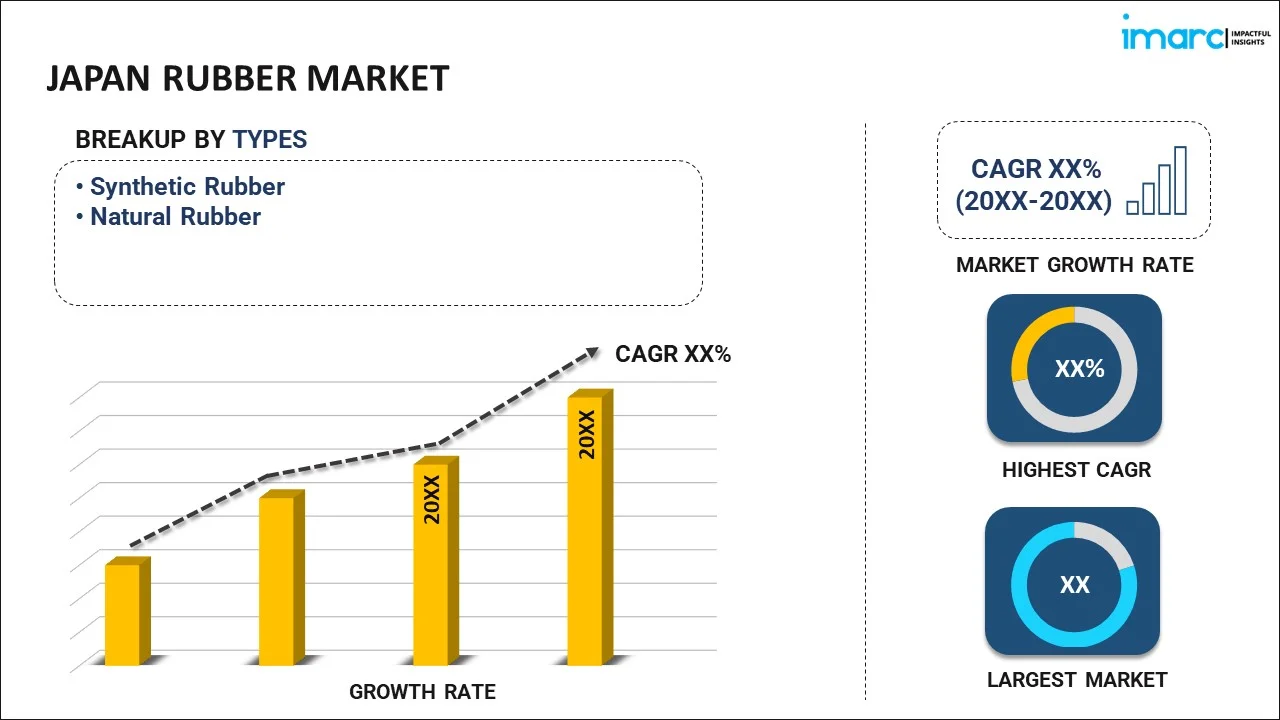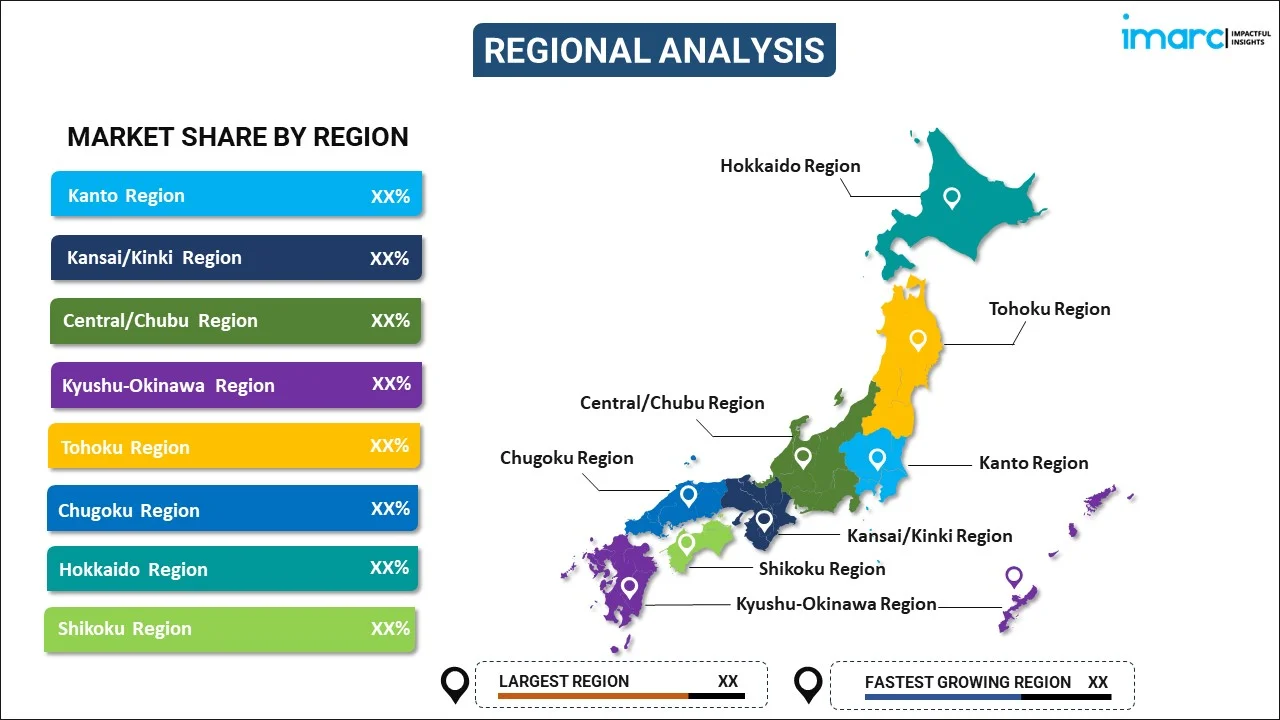
Japan Rubber Market Report by Type (Synthetic Rubber, Natural Rubber), Application (Tire, Non-Tire Automotive, Footwear, Industrial Goods, and Others), and Region 2025-2033
Market Overview:
Japan rubber market size reached USD 49.0 Billion in 2024. Looking forward, IMARC Group expects the market to reach USD 153.3 Billion by 2033, exhibiting a growth rate (CAGR) of 13.52% during 2025-2033. The market is being propelled by several significant factors, including the growing sales of high-end automobiles, the increasing in construction projects, and the introduction of intelligent rubber materials.
|
Report Attribute
|
Key Statistics
|
|---|---|
|
Base Year
|
2024 |
|
Forecast Years
|
2025-2033 |
|
Historical Years
|
2019-2024
|
| Market Size in 2024 | USD 49.0 Billion |
| Market Forecast in 2033 | USD 153.3 Billion |
| Market Growth Rate (2025-2033) | 13.52% |
Rubber is a highly resilient and waterproof substance that originates from the sap of rubber tree. The process involves tapping the tree bark to extract the sap, followed by coagulation and further processing to produce the rubber material. Rubber's unique attributes find utility in a range of uses, including the manufacturing of tires, footwear, adhesives, and industrial components. Its elasticity allows it to stretch and revert to its original form, and its durability and resistance to water contribute to its longevity. In recent times, there has been an increasing interest in synthetic rubber produced in laboratories, offering the potential to engineer novel materials with specific characteristics tailored for diverse applications.
Japan Rubber Market Trends:
The Japanese rubber market is experiencing robust growth driven by several key factors. One of the primary drivers is the increasing demand for rubber products across various industries. The automotive sector, in particular, relies heavily on rubber for manufacturing tires, belts, and hoses. Additionally, the rising popularity of electric vehicles (EVs) is poised to have a substantial influence on the Japan rubber market. Besides this, EVs require specialized tires and rubber components with different properties and enhanced durability compared to traditional gasoline-powered vehicles, which is bolstering the market growth. Furthermore, the development of infrastructure projects, including roads, bridges, and buildings, is a driving force behind regional market. These projects demand substantial quantities of rubber materials for applications such as sealing, insulation, and vibration control. Environmental concerns have also spurred demand for sustainable and eco-friendly materials, leading to increased interest in natural rubber and synthetic rubber derived from renewable sources like bio-based feedstocks. Moreover, ongoing technological advancements and innovations in rubber production and applications are strengthening market growth. Apart from this, the development of novel rubber formulations and production methods holds the promise of enhancing the performance and longevity of rubber products, which is expected to catalyze the market growth in the coming years.
Japan Rubber Market Segmentation:
IMARC Group provides an analysis of the key trends in each segment of the market, along with forecasts at the country level for 2025-2033. Our report has categorized the market based on type and application.
Type Insights:

- Synthetic Rubber
- Natural Rubber
The report has provided a detailed breakup and analysis of the rubber market in Japan based on the type. This includes synthetic rubber and natural rubber.
Application Insights:
- Tire
- Non-Tire Automotive
- Footwear
- Industrial Goods
- Others
A detailed breakup and analysis of the market based on the application have also been provided in the report. This includes tire, non-tire automotive, footwear, industrial goods, and others.
Regional Insights:

- Kanto Region
- Kansai/Kinki Region
- Central/ Chubu Region
- Kyushu-Okinawa Region
- Tohoku Region
- Chugoku Region
- Hokkaido Region
- Shikoku Region
The report has also provided a comprehensive analysis of all the major regional markets, which include Kanto Region, Kansai/Kinki Region, Central/ Chubu Region, Kyushu-Okinawa Region, Tohoku Region, Chugoku Region, Hokkaido Region, and Shikoku Region.
Competitive Landscape:
The market research report has also provided a comprehensive analysis of the competitive landscape. Competitive analysis such as market structure, key player positioning, top winning strategies, competitive dashboard, and company evaluation quadrant has been covered in the report. Also, detailed profiles of all major companies have been provided. Some of the key players include:
- Asahi Rubber Inc.
- Bridgestone Corporation
- Marugo Rubber Industries Ltd.
- Meiji Rubber & Chemical Co. Ltd.
- Mizuuchi Rubber Industries Co. Ltd.
- Nishikawa Rubber Co. Ltd.
- Sumitomo Rubber Industries Ltd.
- The Yokohama Rubber Co. Ltd.
- Toyo Tire Corporation
(Please note that this is only a partial list of the key players, and the complete list is provided in the report.)
Japan Rubber Market Report Coverage:
| Report Features | Details |
|---|---|
| Base Year of the Analysis | 2024 |
| Historical Period | 2019-2024 |
| Forecast Period | 2025-2033 |
| Units | Billion USD |
| Scope of the Report | Exploration of Historical Trends and Market Outlook, Industry Catalysts and Challenges, Segment-Wise Historical and Future Market Assessment:
|
| Types Covered | Synthetic Rubber, Natural Rubber |
| Applications Covered | Tire, Non-Tire Automotive, Footwear, Industrial Goods, Others |
| Regions Covered | Kanto Region, Kansai/Kinki Region, Central/ Chubu Region, Kyushu-Okinawa Region, Tohoku Region, Chugoku Region, Hokkaido Region, Shikoku Region |
| Companies Covered | Asahi Rubber Inc., Bridgestone Corporation, Marugo Rubber Industries Ltd., Meiji Rubber & Chemical Co. Ltd., Mizuuchi Rubber Industries Co. Ltd., Nishikawa Rubber Co. Ltd, Sumitomo Rubber Industries Ltd., The Yokohama Rubber Co. Ltd., Toyo Tire Corporation, etc. |
| Customization Scope | 10% Free Customization |
| Post-Sale Analyst Support | 10-12 Weeks |
| Delivery Format | PDF and Excel through Email (We can also provide the editable version of the report in PPT/Word format on special request) |
Key Questions Answered in This Report:
- How has the Japan rubber market performed so far and how will it perform in the coming years?
- What has been the impact of COVID-19 on the Japan rubber market?
- What is the breakup of the Japan rubber market on the basis of type?
- What is the breakup of the Japan rubber market on the basis of application?
- What are the various stages in the value chain of the Japan rubber market?
- What are the key driving factors and challenges in the Japan rubber?
- What is the structure of the Japan rubber market and who are the key players?
- What is the degree of competition in the Japan rubber market?
Key Benefits for Stakeholders:
- IMARC’s industry report offers a comprehensive quantitative analysis of various market segments, historical and current market Japan rubber market trends, market forecasts, and dynamics of the market from 2019-2033.
- The research report provides the latest information on the market drivers, challenges, and opportunities in the Japan rubber market.
- Porter's five forces analysis assist stakeholders in assessing the impact of new entrants, competitive rivalry, supplier power, buyer power, and the threat of substitution. It helps stakeholders to analyze the level of competition within the Japan rubber industry and its attractiveness.
- Competitive landscape allows stakeholders to understand their competitive environment and provides an insight into the current positions of key players in the market.
Need more help?
- Speak to our experienced analysts for insights on the current market scenarios.
- Include additional segments and countries to customize the report as per your requirement.
- Gain an unparalleled competitive advantage in your domain by understanding how to utilize the report and positively impacting your operations and revenue.
- For further assistance, please connect with our analysts.
 Inquire Before Buying
Inquire Before Buying
 Speak to an Analyst
Speak to an Analyst
 Request Brochure
Request Brochure
 Request Customization
Request Customization




.webp)




.webp)












